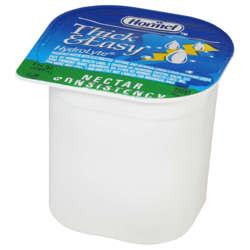
However, what we really care about is not the short term risk of aspiration of thin liquids during the exam, but the longer term outcomes like pneumonia which is the primary cause of death seen with aspirations. Most of what we have regarding the benefits of thickened liquids comes from bedside or videofluoroscopic evaluation looking at risk of aspiration during the evaluation. Thickened liquids are most commonly used in individuals with dysphagia to improve the ability to safely swallow liquids with the hopes of preventing aspiration, pneumonia, and death. If this many individuals are on thickened liquids, there has to be some evidence to back it up, right? Of these individuals getting thickened liquids, 30% were getting honey consistency thickened liquids and 60% were getting nectar thick (which is less viscous than honey thick). For instance, in one s tudy published in 2004 in the Journal of the American Dietetic Association, one out of twelve nursing home residents in the U.S. The longer you cook your sauce or soups, though, the better the flavor will be.There are a lot of people with swallowing difficulty who are currently getting thickened liquids.

Starches offer a low-fat, simple thickening alternative for sauces that is especially suitable for beginning cooks. Some bubbling is fine, but do not keep the sauce at a boil. Cook the sauce over medium to medium-low heat for 30 minutes or more, stirring occasionally with a spoon or whisk, to give it a smooth, velvety texture.Gradually whisk your roux into your sauce.For a dark roux, continue cooking and stirring constantly until you start to smell a nutty aroma, and your roux is a caramel color. A darker roux has a darker brown coloring and a nuttier flavor. At this stage, decide how dark you want your roux to be.Once the butter has melted, gradually add in the flour, whisking constantly until it’s combined and smooth.Add just a little bit of oil to the pan to keep the butter from burning.

Heat the butter over medium heat in a saucepan, until it’s melted.

Cooking the flour in the butter will help remove the pasty taste of the flour.

Roux also uses an equal ratio of flour to butter. Use two tablespoons (16 g) of butter and all-purpose flour. X Research source A roux is an excellent way to make thick stews, gravy, gumbo, or cheese sauce.


 0 kommentar(er)
0 kommentar(er)
